2.1 Creating a New GroupWise System in a Windows Failover Cluster
The following sections assume a working knowledge of Windows Server Failover Clustering.
2.1.1 Preparing to Install GroupWise in the Cluster
This section includes instructions for creating a cluster role using the role type of “File Server”. For each server that you configure with this role, you must have already installed File Server through Server Manager in order to configure it as described below.
-
Define at least one Cluster Role.
For a very simple GroupWise system with a primary domain and one post office, you could handle the domain and the post office as a single Cluster Role. For a typical GroupWise system with multiple domains and post offices, you might to have a Cluster Role for each domain and post office.
-
Configure each Cluster Role with the type of File Server.
-
Configure each File Server Cluster Role with a shared cluster disk and an IP address.
The following example shows two Cluster Roles, ProvoServer and UtahServer.
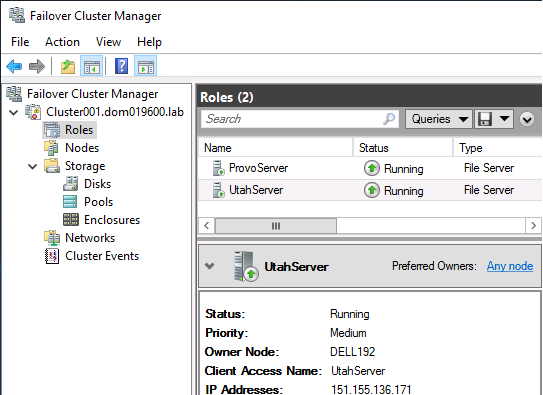
-
Continue with Installing the GroupWise Software.
2.1.2 Installing the GroupWise Software
To install the GroupWise software:
-
Install the GroupWise Server component on each cluster node where a GroupWise agent will run for a domain or a post office.
Follow the instructions in Step 1 through Step 11 in
Windows: Installing the GroupWise Server Software
in the GroupWise Installation Guide.IMPORTANT:Install the GroupWise Server component on all cluster nodes before setting up any domains or post offices.
-
Continue with Configuring the GroupWise Admin Service for Clustering.
2.1.3 Configuring the GroupWise Admin Service for Clustering
Configuring the GroupWise Admin Service for clustering ensures that files associated with domains and post offices are created on cluster volumes, rather than on individual cluster nodes.
|
File |
Standard Location |
Clustered location |
|---|---|---|
|
Domain SSL Certificate, MTA SSL Certificate, GWIA SSL Certificate |
C:\Program Files\Novell\ GroupWise Server\ certificates |
\groupwise\certificates (a peer to the domain folder) |
|
Post Office SSL Certificate, POA SSL Certificate |
C:\Program Files\Novell\ GroupWise Server\ certificates |
\groupwise\certificates (a peer to the post office folder) |
|
MTA Log Files |
\domain_folder\mslocal |
\groupwise\agents\logs (a peer to the domain folder) |
|
GWIA Log Files |
\domain_folder\wpgate\000.prc |
\groupwise\agents\logs (a peer to the domain folder) |
|
POA Log Files |
\post_office_folder\wpcsout\ofs |
\groupwise\agents\logs (a peer to the post office folder) |
-
Run the following command to enable the GroupWise Admin Service to run in a clustering environment:
gwadminutil config -cluster enable
You should receive the following response:
Cluster: enabled Default Port: 9710
-
Restart the GroupWise Admin Service.
Use the Windows Services administrative tool.
or
Use the following commands at the Windows command prompt:
sc stop gwadmin sc start gwadmin
-
Continue with Creating the Primary Domain.
2.1.4 Creating the Primary Domain
To create a primary domain:
-
Ensure that the primary domain Cluster Role is online on the cluster node where you want to create the primary domain.
-
Use the GroupWise Install icon on the Windows desktop to access the GroupWise Installation console.
-
(Conditional) If you receive a certificate error, continue past it.
-
Follow the instructions in
Creating the Primary Domain
in the GroupWise Installation Guide.Pay special attention to the Host and Domain Folder fields on the System Settings page.
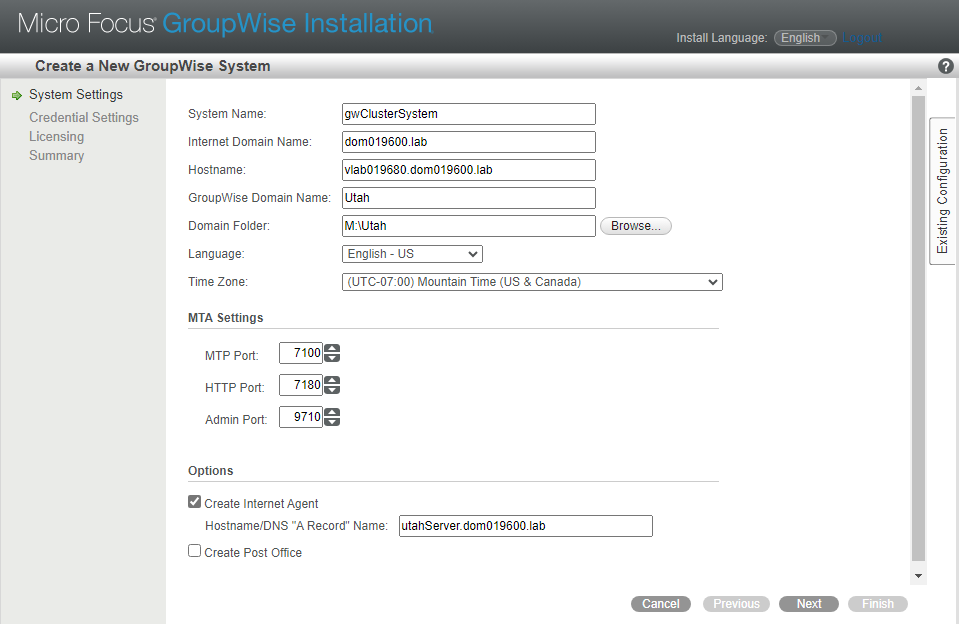
-
In the Host field, specify the IP address of the domain Cluster Role.
-
In the Domain Folder field, specify a folder on the domain Cluster Role volume.
The clustering example used in this section sets up a GWIA in the primary domain but does not create any post offices on the primary domain server. The post office will be created later on a different Cluster Role.
-
-
Continue following the standard instructions to finish creating the primary domain.
NOTE:After you create the primary domain on its Cluster Role, the GroupWise Install and GroupWise Administration desktop icons no longer work. The Admin Service is now listening on the IP address of the primary domain Cluster Role, not the IP address of the physical node.
-
(Optional) Create new desktop shortcuts for the Installation console and the Administration console that use the proper IP address.
-
Continue with Creating a Post Office.
2.1.5 Creating a Post Office
Although you can create a post office on the same Cluster Role with a domain, it is not typical to do so. In this example, the post office is created on a separate Cluster Role.
-
Online the post office Cluster Role to a cluster node.
-
Use the GroupWise Install icon on the Windows desktop to access the GroupWise Installation console.
-
Follow the instructions in Step 2 through Step 8 in
Adding a Post Office
in the GroupWise Installation Guide.As with the domain creation process, pay special attention to specific fields.
-
On the System Settings page:
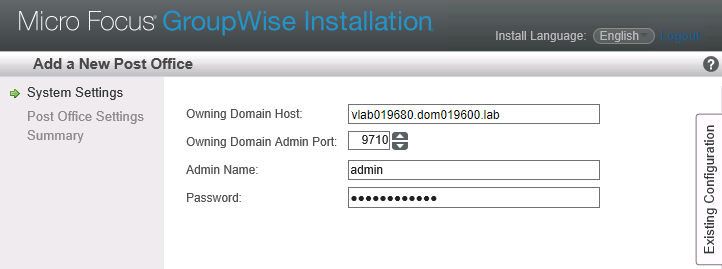
-
In the Owning Domain Host field, specify the IP address of the primary domain Cluster Role that you set up in Creating the Primary Domain.
-
In the Owning Domain Admin Port field, specify port on the primary domain Cluster Role.
-
-
On the Post Office Settings page:
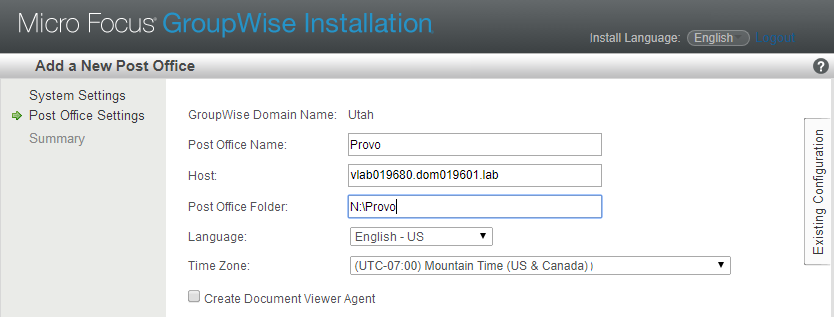
-
In the Host field, specify the IP address of the post office Cluster Role.
-
In the Post Office Folder field, specify a folder on the post office Cluster Role volume.
The clustering example used in this section does not set up a DVA with the post office. For DVA clustering recommendations, see Clustering the DVA.
-
-
-
Continue following the standard instructions to finish creating the post office.
NOTE:As an alternative to creating the post office in the GroupWise Installation console, you can create the post office in the GroupWise Admin console. Online the post office Cluster Role to the same node where the owning domain Cluster Role is running. Then follow the instructions in
Creating a New Post Office on an Existing Domain or Post Office Server
in the GroupWise Installation Guide.
2.1.6 Creating a Script to Start and Stop the GroupWise Agents
When a domain or post office Cluster Role is started, stopped, or moved to a new cluster node, the accompanying GroupWise agents must also be started and stopped. The GroupWise Admin Service also needs to keep track of when domains and post office are added or removed from its cluster node. This is accomplished by adding a Windows cluster Generic Script resource to the domain or post office Cluster Role.
The Generic Script performs the following actions:
-
Creates a Windows service for each GroupWise agent if the service does not already exist.
-
Starts the GroupWise Admin Service for the domain or post office Cluster Role.
-
Starts the MTA, and optionally the GWIA, for a domain Cluster Role.
-
Starts the POA for a post office Cluster Role.
The Generic Script must be a Visual Basic script. A template is provided in the following location:
C:\Program Files\Novell\GroupWise Server\ agents\data\cluster\groupwise_cluster_template.vbs
The script file provides background information about how to edit the script.
-
Create a folder for the script on each cluster node, such as c:\gwcluster.
-
Copy the template script into the gwcluster folder on each cluster node.
-
Edit the template file for a specific Cluster Role.
For a domain Cluster Role, the script would look similar to the following example, which enables the MTA and the GWIA for the Utah domain:
gwAgents.Add "Utah MTA", "M:\Utah" gwAgents.Add "Utah GWIA", "M:\Utah\wpgate\gwia"
For a post office Cluster Role, the script would look similar to the following example, which enables the POA for the Provo post office:
gwAgents.Add "Provo POA", "M:\Provo"
-
Save the edited template file with a descriptive name that associates it with its Cluster Role.
-
Copy the customized script to each cluster node, ensuring that it is in the same location on all cluster nodes.
-
Continue with Adding the Script to the Cluster Role.
2.1.7 Adding the Script to the Cluster Role
To add a script to the cluster role:
-
In the Failover Cluster Manager, stop or offline the Cluster Role.
-
Highlight the Cluster Role.

-
On the Actions menu in the right column, click Add Resource > Generic Script.
-
Select Generic Script as the resource type.
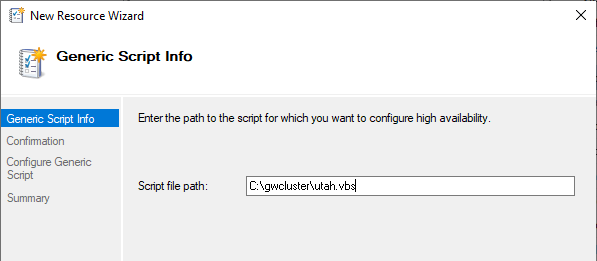
-
Specify the full path to the script.
-
Click Next, and then click Finish.
IMPORTANT:If there are any errors in the script, or if the script is not available on all of the cluster nodes, the addition of the Generic Script resource fails.
-
Edit the properties of the script to add dependencies, so that the file system and IP address are enabled on the Cluster Role before the script is run.
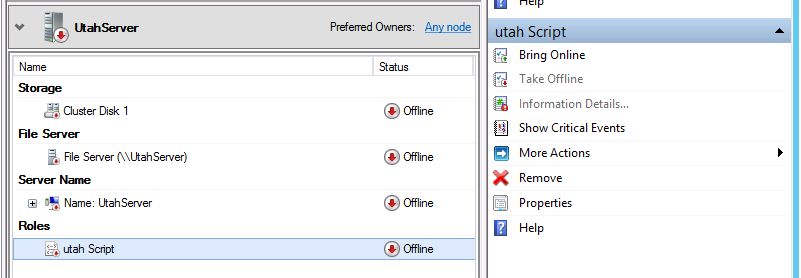
-
Highlight the Generic Script resource, and then click Properties on the Script menu on the right.
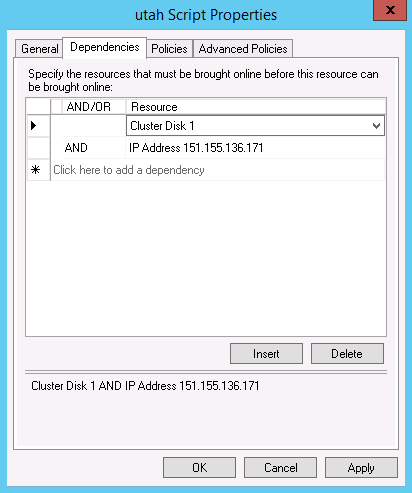
-
Click the Dependencies tab.
-
Click Click here to add a dependency, and then select the Cluster Disk as the first dependency.
-
Click Click here to add a dependency again, and then add the IP address.
-
Click OK to save your changes.
-
-
Continue with Testing the Cluster Role.
2.1.8 Testing the Cluster Role
To test the cluster role:
-
Bring the Cluster Role online.
-
Move the Cluster Role to a different node.
2.1.9 Clustering the DVA
Complete instructions for clustering the DVA are beyond the scope of this example. The following suggestions should help you cluster the DVA:
-
Do not install the DVA as part of installing a post office. Instead, install it independently. Use the following command on the cluster disk where you want the DVA to run:
gwsc -i -dva
For more instructions, see the following sections in the GroupWise Installation Guide:
-
Create a script and a Generic Script resource to control the DVA. The line for the DVA would look similar to the following example:
gwAgents.Add "GWDVA", "M:\Provo"
For instruction, see:
-
Configure the DVA to function in the cluster.
This requires editing the DVA startup file. For instructions, see
Configuring DVA Log Settings
in the GroupWise Administration Guide.Two aspects of the DVA must to customized:
-
Configure the DVA with the IP address of the Cluster Role.
-
Configure the DVA to create its log files in the following folder:
\groupwise\agents\logs
If you are setting up the DVA as part a post office Cluster Role, this folder has already been created when you configured the GroupWise Admin Service to run for the clustered post office. If not, you must manually create this folder. In either case, you must configure the DVA to have its log files created in this location.
-